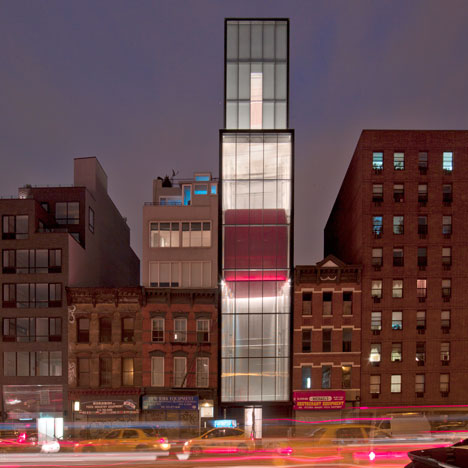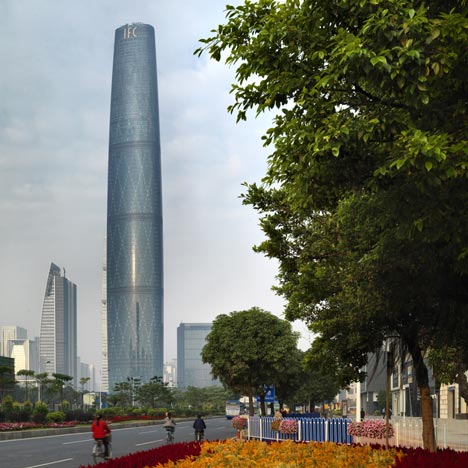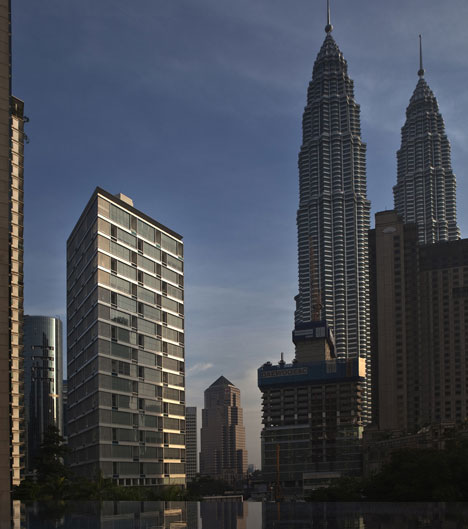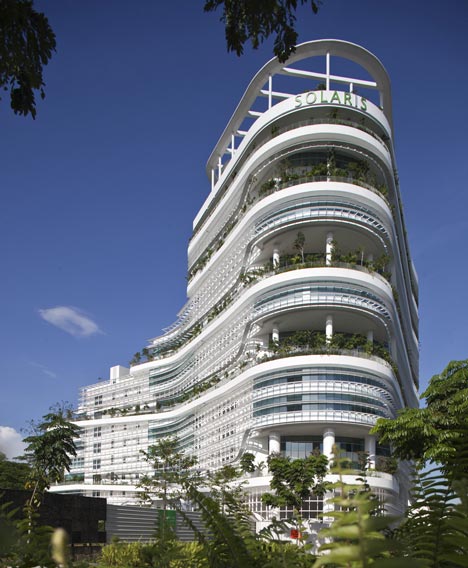
2012 RIBA Lubetkin Prize shortlist announced
Dezeen Wire: a New York gallery by Foster + Partners (above) is one of four buildings shortlisted for this year's RIBA Lubetkin Prize, which is awarded annually to the best new building outside Europe by an RIBA member.
The four shortlisted entries are:
» Guangzhou International Finance Centre, China, by Wilkinson Eyre Architects
» One KL, Kuala Lumpar, Malaysia by SCDA Architects
» Solaris, Singapore by TR Hamzah and Yeang and CPG
» Sperone Westwater, Bowery, New York by Foster + Partners

Above: Guangzhou International Finance Centre by Wilkinson Eyre Architects
The winner will be announced at a ceremony in Manchester on 13 October, when the winner of the Stirling Prize will also be revealed.

Above: One KL by SCDA Architects
The Stirling Prize nominees for the best building designed or built in the UK were announced earlier this week. See them all here.

Above: Solaris by TR Hamzah and Yeang and CPG
Here's the full press release from the RIBA and a description of each project:
The Royal Institute of British Architects (RIBA) is pleased to announce today the shortlist for the 2012 RIBA Lubetkin Prize, given to the best new international building outside the EU. This year’s shortlist recognises three exceptional new buildings in South East Asia and one in the USA.
The Guangzhou International Finance Centre in China, the tallest building in the world by a UK architect; the Solaris science research and development centre in Singapore, an incredible feat in green building; the One KL apartment development in Malaysia which cleverly tackles the humidity of the city; and Foster + Partner’s highly imaginative Sperone Westwater gallery in New York City, are all competing to win the prize.
The winner of the RIBA Lubetkin Prize will be announced on the evening of Saturday 13 October at a special event in Manchester (UK).
Speaking today, Angela Brady, RIBA President, said:
“We have four highly experienced architecture practices on the 2012 RIBA Lubetkin Prize shortlist offering sophisticated yet lively responses to complex and very different sites. These cutting-edge buildings show the leading role that architects play in creating low-energy living and working spaces, even in extreme environmental conditions.”
The jury selecting the shortlist was chaired by RIBA President Angela Brady with architects Deborah Saunt, Cindy Walters, Philip Gumuchdjian and RIBA Head of Awards Tony Chapman.
1. Guangzhou International Finance Centre
Guangzhou, China
Architect: Wilkinson Eyre Architects
Client: Guangzhou Yuexiu City Construction
Structural Engineer: Arup
Services Engineer: Arup
Contractor: China State Construction Corporation
Contract Value: £600 million
Date of completion: June 2011
Gross internal area: 380,000 sq m
The Guangzhou International Finance Centre is the tallest building designed by a British architect, anywhere in the world, ever. Wilkinson Eyre won the competition with a slender triangular mixed use tower rising to 103 storeys out of a podium containing shopping and a connection to the subway system and three levels of parking, as well as two linked smaller towers of accommodation.
The main tower is 66 floors of offices and 38 floors of a Four Seasons hotel arranged around a dramatic tapering atrium. For all the smoothness of its crystalline skin, this is a building that expresses its diagonal grid structure to the world through its glazed facades and internally to the user of every office and hotel room through the presence of raked concrete-filled steel tubes that form the structure.
The beauty of the diagonal grid is its inherent stiffness, which in turn gives it its strength. Each diamond is 54 metres or twelve storeys high, reducing the amount of steel required for the construction by a remarkable 20%.
Originally planned as one of a matching pair of towers either side of a grand pedestrian boulevard leading to last year’s Lubetkin shortlisted Opera House by Zaha Hadid, it was also designed with a double skin. That fell victim to the client’s understandable desire for more floor space (and certainly the generosity of the floorplate between core and skin is one of the building’s major selling points). Instead the sun protection that a double skin would have afforded has had to be built into the glass – hence the dark grey appearance, again a distinctive merit of the finished tower.
This is a hugely complex project that appears to be extraordinarily simple, like most of the best things in life.
2. One KL
Kuala Lumpur, Malaysia
Architect: SCDA Architects
Client: Waterfront Group
Structural Engineer: -
Services Engineer: -
Contractor: Shimizu Corporation
Contract Value: Confidential
Date of completion: March 2010
Gross internal area: 45,245 sq m
One KL is a 35 storey residential tower with a prestige to match the exclusivity of its address. Each duplex has its own pool, rectangular or L shaped depending on the location of the apartment. These mini-infinity pools are expressed on the façade with glass end-walls, making them an outward manifestation of the desirability of the accommodation within.
The tower is C shaped so as to make the best use of a tight urban site. It means that it has three fronts and three backs, the missing fourth elevation draws the wind and negative pressure, pushing it up the void and cross ventilating the structure through the cuts made by the terraces and pools. Condensation produced by the air crossing the pools also results in local cooling.
The dual aspect of each apartment has other advantages. It brings light into all the rooms and also produces what is probably architecturally the most interesting space – the void - with its dramatic escape stairs. Another space which benefits from the indoor-outdoor ambiguity is the third level slice of communal living comprising pool, gardens, gym and multi-functional space.
On the outside the architects have played with the grid, alternately sliding the apartments to the left or the right to allow for the pools and terraces, so that the units interlink, giving these elevations a rhythm that enlivens the whole composition. Internally, the generosity of the spaces allows the interest to be continued with double and single-height spaces interlocking, so that a mezzanine corridor overlooking the living-dining spaces and joins the bedrooms. In the penthouses the device continues on up through a further two floors to a magnificent roof terrace.
Kuala Lumpur has some of the highest levels of humidity in the world – 95% being common. This building, by architects who been working on the problem for more than a decade, have produced apartments that go far beyond the anodyne air-conditioned box.
3. Solaris
Fusionopolis 2B, One North, Singapore
Architect: TR Hamzah and Yeang and CPG
Client: Soilbuild Group Holdings
Structural Engineer: Arup Singapore
Services Engineer: CPG Consultants
Contractor: Soil-Build
Contract Value: £49.9 million
Date of completion: March 2011
Gross internal area: 51,274 sq m
Ken Yeang’s approach to designing buildings to cope naturally with extreme climates has been hugely important and his ideas disseminated in a series of influential books. But it is only when you see one of his buildings that you understand that they work aesthetically as well as they do environmentally.
Solaris is two big buildings, one seven, one fourteen storeys, linked by a generous daylit and naturally ventilated atrium with rooflights that close automatically when it rains and crossed by sky-brides at high level. A rain-check glass wall made up of glazing separated by perforated panels also keeps out the rain while allowing cross ventilation.
This is a green building in every sense of the word. A narrow landscaped ramp, more like a stony country path, wraps itself round the building for 1.5 kilometres, rising from ground level up to a roof garden with dramatic views of one third of Singapore. It provides walks for the buildings’ users and a habitat for birds, butterflies and even the occasional snake. Altogether the landscaping exceeds the amount of greenfield land taken up by the building by 13% - giving it an impressive Green Mark rating of 113%. Included within this figure are the sky terraces, where the linear path broadens out into wide hard landscaped but well-planted terraces where staff can meet up – an important provision in a building whose primary function is scientific research and development.
Precisely shaped sun-shading louvres supplement the hard-working low emissivity glass, resulting in relatively cool open plan office spaces even when the air con is turned off. In the deeper plan of the two buildings, a broad light-well or ‘solar shaft’ runs diagonally through the section, scooping light into the heart of the building and reducing the need for artificial lighting. Rainwater harvesting stores enough water (700 cubic metres) underground to irrigate the landscaping for five days.
Consquently Solaris has very low carbon emissions, just 62 kilograms of carbon per square metre. What is more, it is designed to be easily adaptable to other uses, or its components to be almost entirely recyclable should no such alternative use be found. The result is a building that has achieved the local Building and Construction Authority’s Green Mark Platinum Standard. This is a building where the organic meets the inorganic in a most satisfying and pleasing manner.
4. Sperone Westwater
Bowery, New York City, USA
Architect: Foster + Partners
Client: Sperone Westwater
Structural Engineer: Buro Happold
Services Engineer: Buro Happold
Contractor: Sciame
Contract Value: Confidential
Date of completion: September 2010
Gross internal area: 1858 sq m
A sensitive, sympathetic client, a generous budget, a programme built on selling the art of some of the world’s top artists in one of New York’s longest established private galleries – it sounds like a dream commission. And then there is the site: just 7.6 metres wide by 30.5 metres deep, a narrow slot in the Bowery, amid the second-hand kitchenware stores. In less able hands this site could have produced a curator’s nightmare. Instead this is a mature, thoughtful and polished piece of work: a curator’s dream.
Externally, by day this building is as tough as any in the Bowery, a slender, milled glass fortress that relates in scale to the buildings around it. By day it has the air of fine steel, by night its transparency shines through, not least in the moving room. This additional 6 by 3 metre gallery space is also the goods lift which can be parked at any of the four floors of galleries above the entrance level. If it is in use as an extended gallery space, then circulation is via the lift and stair core towards the rear of the building. Only ground conditions prevented the moving room from descending to occupy the street level entry. Instead there the drama of a double-height lobby with the lift parked excitingly overhead. This leads through to a double-height long gallery. A smoothly curved mezzanine gallery overlooking the long gallery, with a beautifully detailed polished steel handrail, leads to a sculpture terrace above a secret garden ‘borrowed’ from the adjacent apartment block. Only its occupants can enjoy the fineness of the rear elevation and the way it melds into the cityscape, but all gallery-goers can enjoy the views of this rare wooded green space and of the public park beyond.
The progression of galleries continues upwards, each floor subtly different in plan and feel: a conventional gallery topped with two ‘his and her’ floors reflecting the different styles of the two owners, Sperone and Westwater; then up again to offices (which could become another gallery) and finally a library and archive worthy of any grand villa.
This is a gallery which perfectly serves both its private and public functions: discreet rooms for conversations with potential buyers and public galleries as fine as any in New York City. This is architecture that advertises its subject and itself equally well. A little masterpiece.